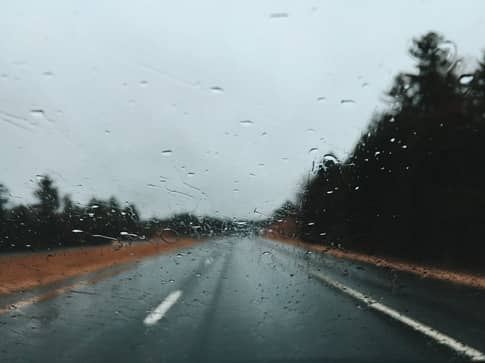Driving in Wet Conditions
16 October 2017
Wet conditions make roads slippery, reduce your visibility and decrease your gripping capabilities, so no wonder many motorists find the prospect of rain daunting!
When rain strikes, it is important that you modify your driving style to keep yourself and passengers safe. Take a look at our helpful advice and make sure you are driving as safely as possible in wet weather conditions.

Be Prepared
It is important that both you and your vehicle are prepared for driving in rain and wet conditions.
Vehicle Checks
- Ensure that your tyres have at least 3mm of tread – any less than this and your gripping capabilities and braking distances will be drastically affected. Learn how to check your tyre tread.
- Check your windscreen wipers for signs of damage such as frays or cuts and replace them if they do not clear your windscreen or leave smears.
- Make sure that all your lights are working correctly.
- Top up your screen wash if it is below the minimum marking on the washer fluid container.
Before You Set Off
Always check the weather forecast before a journey and if heavy rain is predicted you may want to reconsider if you need to drive. If you decide to go out in wet weather, take a mobile phone with you in case you run in to difficulty and try to avoid routes that are prone to flooding.
You should always allow more time for a journey in wet weather conditions.
Slow Down
The golden rule for driving in rain is to slow down. Water causes road surfaces to become slippery and this makes it harder for your tyres to retain contact, especially if you are travelling at speed.
Braking distances are increased in wet weather so you should leave more space between your vehicle and the one in front so you have adequate time to slow down when necessary.
See and Be Seen
During heavy rain, visibility on the road becomes reduced. Remember if you are struggling to see other cars, they are struggling to see you so turn on your dipped headlights.
Large vehicles often cause water to spray, so if a lorry is about to pass you turn up the speed of your windscreen wipers to avoid your view becoming obstructed.
Aquaplaning
Aquaplaning can happen when your tyres lose contact with the surface of the road and cause the vehicle to effectively surf on top of the water. This can be dangerous as you have little control over the vehicle. Aquaplaning is caused by wet surfaces and speed, so do try to remain at a lower speed to avoid it. More worn tyres are also more prone to aquaplaning as they do not have sufficient tread to retain grip.
If you do find yourself aquaplaning, you must avoid the temptation to brake. Although this will feel like the most natural response, sharply braking is likely to cause you to skid. Instead, gently ease off the accelerator and allow your tyres to slow down naturally and regain traction. Do not sharply steer, keep the steering pointing in the direction of travel.
Avoid Flooded Areas
Deep standing water is extremely dangerous to drive through and can cause irreparable damage to your vehicle.
If you have no other option than to drive through a flood, you should always gauge the depth first. If it is deeper than four inches, it would be wise to avoid. You can check the depth by watching other cars travelling through, again, if there are no other cars around you should find an alternate route.
When driving through water, stick to a very low speed and do not accelerate or slow down as either can cause aquaplaning or vehicle damage. Stick to the highest section of the road and check that your route is clear first - do not stop your vehicle in water!
As soon as you exit the water, you should test your brakes by lightly applying them.
For further advice on driving in wet conditions contact your local Setyres branch.